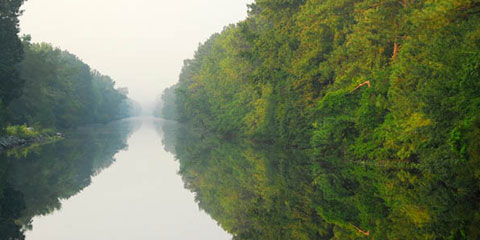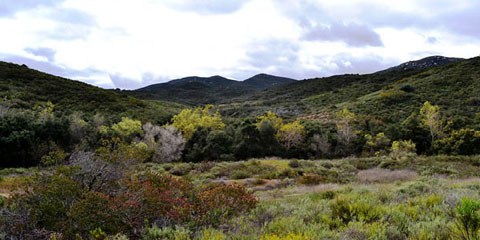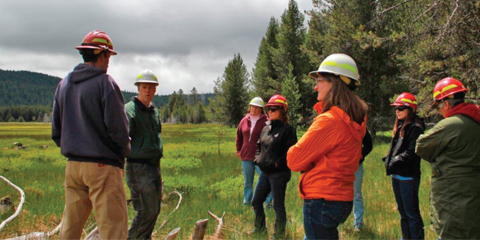Agency Examples
Several federal agencies have already begun exploring or applying ecosystem services in their decision processes. This section of the guidebook, authored primarily by agency staff, provides a range of specific examples of these efforts—from analyses of ecosystem services in specific decision contexts like national forest planning and siting of energy infrastructure to discussions of ways to integrate the ecosystem services concept into institutional programs and operations.
These examples are a mix of those published by the National Ecosystem Services Partnership upon printing of the guidebook in 2014 and others that agencies have since created.
Bureau of Land Management
-
An Ecosystem Services Approach to Sage-Grouse Conservation: Upper Green River Conservation Exchange Program (2014)
 View PDF
View PDFDescribes a collaborative effort to protect habitat for sage-grouse in advance of the species’ potential listing by the Fish and Wildlife Service under the Endangered Species Act.
-
Protecting Ecosystem Services While Developing Renewable Energy: Bureau of Land Management Solar Energy Program (2014)
 View PDF
View PDFDescribes a program that defines how utility-scale solar energy is considered and developed on BLM-managed lands.
U.S. Department of Agriculture
-
Assessing Pollinator Habitat Services to Optimize Conservation Programs
 View PDF
View PDFDescribes how pollination services have received increased attention over the past several years, and protecting foraging area is beginning to be reflected in conservation policy. Includes prospects for doing so in a more analytically rigorous manner, by quantifying the pollination services for sites being considered for ecological restoration.
-
The Valuation of Ecosystem Services from Farms and Forests
 View PDF
View PDFDescribes a systematic approach to quantifying benefits of conservation programs.
-
Ecosystem Service Benefits Generated by Improved Water Quality from Conservation Practices
 View PDF
View PDFDescribes conservation practices on farms within the Western Lake Erie Basin used to illustrate methods for estimating monetary values and non-monetary benefit indicators for five ecosystem service benefits generated by improved water quality.
-
Estimated Values of Carbon Sequestration Resulting from Forest Management Scenarios
 View PDF
View PDFDescribes how the use of detailed forest inventory data was used to project the carbon impacts of a range of modeled policies through 2060.
U.S. Environmental Protection Agency
-
Making Ecosystem Services the Focus of Determining Adversity to Public Welfare in Review of NOx and SOx Secondary Air Quality Standards (2014)
 View PDF
View PDFDescribes how the NOx/SOx standards review set a precedent for use of ecosystem services in risk assessments and provides examples of the methodologies for doing.
U.S. Fish and Wildlife
-
Incorporating Consideration of Ecosystem Services into Plans for the Great Dismal Swamp National Wildlife Refuge (2014)
 View PDF
View PDFDescribes the potential of an ecosystem services approach to habitat management to yield co-benefits.
-
Incorporating Consideration of Ecosystem Services into Plans for the San Diego National Wildlife Refuge (2014)
 View PDF
View PDFExplores the ways that an ecosystem services approach to planning could help partners achieve multiple shared goals.
-
Using an Ecosystem Services Management Framework to Pursue Watershed-Wide Project Priorities in the Silvio O. Conte National Fish and Wildlife Refuge and Connecticut River Watershed (2014)
 View PDF
View PDFDescribes partnership-building efforts dependent on an ecosystem services framework illuminating the watershed’s services provision.
U.S. Forest Service
-
Integrating Ecosystem Services Into National Forest Service Policy and Operations (2017)
 View PDF
View PDFDescribes Forest Service efforts to integrate ecosystem services in planning, performance and partnerships.
-
What People Value: An Ecosystem Services Approach to Managing Public Lands (2017)
 View PDF
View PDFDescribes how the Forest Service is integrating ecosystem services into national policy and operations, related to decision making, prioritizing, measuring, reporting, communicating, and investing in forest management.
-
Application of Ecosystem Services Concepts to Planning and Implementation Processes in the Inyo, Sierra, and Sequoia National Forests (2014)
 View PDF
View PDFDescribes a bioregional assessment of ecosystem services in California (USFS region 5) designed to information forest-level planning.
-
Sustaining Ecosystem Services across Public and Private Lands: The Cool Soda All Lands Restoration Proposal (2014)
 View PDF
View PDFDescribes a project-level planning pilot in the Willamette National Forest.
-
An Ecosystem Services Approach to Management of a Complex Landscape: The Marsh Project (2014)
 View PDF
View PDFDescribes a project-level planning pilot in the Deschutes National Forest.
-
Ecosystem Services and Land Management Plan Revision: Preliminary Observations of Three Ecosystem Services Evaluation Framework Workgroups Members (2014)
 View PDF
View PDFDescribes how the USFS is implementing the ecosystem services requirement in its 2012 Planning Rule.
-
Integrating Ecosystem Services into U.S. Forest Service Programs and Operations (2014)
 View PDF
View PDFDescribes efforts within the USFS to institutionalize and coordinate ecosystem services activities.
National Oceanic and Atmospheric Administration
-
Operationalizing and Leveraging an Ecosystem Services Framework for Habitat Conservation: Coastal Blue Carbon (2014)
 View PDF
View PDFDescribes NOAA’s efforts to support the scientific, policy, and economic framework needed to increase use of information on coastal wetland’s carbon sequestration potential in coastal management.
-
A Heuristic Framework for Evaluating Ecosystem Services in Coastal and Marine Environments: Marine InVEST (2014)
 View PDF
View PDFDescribes a research project that explores the importance of using an ecosystem services framework to include the effects of watershed-based activities and climate change in management of marine coastal resources.
National Park Service
-
Estimation of Potential Losses from Ozone Damage to the Great Smoky Mountains National Park’s Climate Regulation and Water Provision Services (2014)
 View PDF
View PDFDescribes efforts by the National Park Service to assess how Ozone damage has affected the provisioning of some ecosystem services in the Great Smoky Mountains National Park.
-
Determining Links to the Human Beneficiary: Report from the Air Quality and Ecosystem Services Workshop (2014)
 View PDF
View PDFDescribes the results of a multi-agency, inter-disciplinary workshop held to identify and explore the linkages between air quality in protected park areas, ecosystem services, and human beneficiaries.
